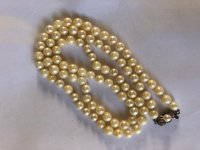lizard
Member
- Joined
- Nov 5, 2010
- Messages
- 72
A friend has brought me her pearls to look at. She says her father brought them back from Japan in the late 1960's and that they are Mikimoto, although she did not expect that they were hugely valuable.
She has had them re-strung and it appears someone has likely changed the order of them, as the graduation has been mixed in the process. She did not bring the original clasp, although I have asked if she can find it.
Looking at them, the lustre is not good (photo looks better than real life). The nacre appears so thin that I at first thought they were shell pearl. It is peeling around the drill holes and the odd patch, even though she says that she has barely worn them.
I am interested in any comments - I expected Mikimoto pearls to be much better quality, even in that period?

![IMG_0015[1].jpg IMG_0015[1].jpg](https://www.pearl-guide.com/data/attachments/50/50672-80b98700699fc6c6d0993a5e15e899a8.jpg?hash=gLmHAGmfxs)
![IMG_0013[1].jpg IMG_0013[1].jpg](https://www.pearl-guide.com/data/attachments/50/50675-d4d247c7c53a764e9623e7d8259cdb67.jpg?hash=1NJHx8U6dk)
She has had them re-strung and it appears someone has likely changed the order of them, as the graduation has been mixed in the process. She did not bring the original clasp, although I have asked if she can find it.
Looking at them, the lustre is not good (photo looks better than real life). The nacre appears so thin that I at first thought they were shell pearl. It is peeling around the drill holes and the odd patch, even though she says that she has barely worn them.
I am interested in any comments - I expected Mikimoto pearls to be much better quality, even in that period?

![IMG_0015[1].jpg IMG_0015[1].jpg](https://www.pearl-guide.com/data/attachments/50/50672-80b98700699fc6c6d0993a5e15e899a8.jpg?hash=gLmHAGmfxs)
![IMG_0013[1].jpg IMG_0013[1].jpg](https://www.pearl-guide.com/data/attachments/50/50675-d4d247c7c53a764e9623e7d8259cdb67.jpg?hash=1NJHx8U6dk)
